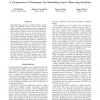Free Online Productivity Tools
i2Speak
i2Symbol
i2OCR
iTex2Img
iWeb2Print
iWeb2Shot
i2Type
iPdf2Split
iPdf2Merge
i2Bopomofo
i2Arabic
i2Style
i2Image
i2PDF
iLatex2Rtf
Sci2ools
106
Voted
AAAI
2004
2004
A Comparison of Techniques for Scheduling Earth Observing Satellites
Scheduling observations by coordinated fleets of Earth Observing Satellites (EOS) involves large search spaces, complex constraints and poorly understood bottlenecks; conditions where stochastic algorithms are often effective. However, there are many such algorithms and the best one to use is not obvious. Here we compare multiple variants of the genetic algorithm, hill climbing, simulated annealing, squeaky wheel optimization and iterated sampling on ten realisticallysized model EOS scheduling problems. Schedules are represented by a permutation (non-temperal ordering) of the observation requests. A simple, greedy, deterministic scheduler assigns times and resources to each observation request in the order indicated by the permutation, discarding those that violate the constraints created by previously scheduled observations. Simulated annealing performs best and random mutation outperforms a more 'intelligent' mutator. Furthermore, the best mutator, by a small margin, was a...
AAAI 2004 | Earth Observing Satellites | Intelligent Agents | Observation Request | Simulated Annealing |
Related Content
| Added | 30 Oct 2010 |
| Updated | 30 Oct 2010 |
| Type | Conference |
| Year | 2004 |
| Where | AAAI |
| Authors | Al Globus, James Crawford, Jason D. Lohn, Anna Pryor |
Comments (0)

